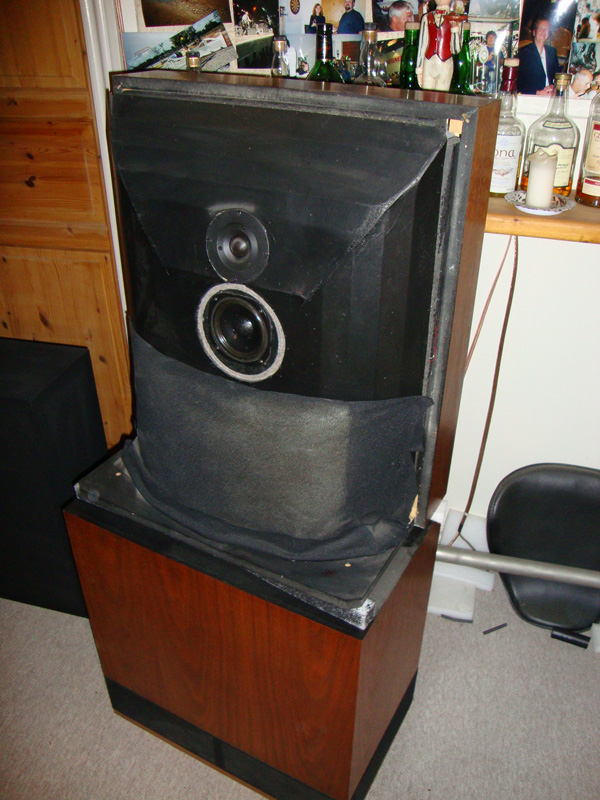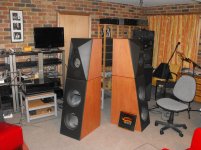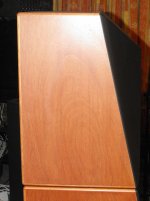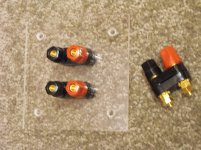Yes, 150 mm re-inforced concrete slab. The brick retaining wall is necessary due to the sloping block. I can't afford fine wines. Feeding the workshop and speakers leaves nothing to spare.I like the footings, do you have the Grange stored under there??
"Moderation is a fatal thing. Nothing succeeds like excess." (Oscar Wilde).
Staining and clearcoat finished
Put on the last two coats of clear and finally get the chance to stand back and have a look. This is the first chance I had seen the two boxes from a distance. I've included an LP and office chair for scale. The maple stain was chosen to match up with the bricks of my listening room. Tomorrow they get stuffed and drivers installed. My aim is for some sound this weekend. I could not find binding posts that I liked, so I got my local plastics fabricator to shape some 100x100 mm (4"x4") terminal plates and fitted some solid amplifier terminals. This will allow the woofers to be in series, bi-wired, and horizontally or vertically bi-amped. I've got some solid (not hollow extrusion) aluminium spiked stands which add about 50 mm (2") to the overall height. The listening position is close to the mid-range axis. I will put them on the scales when the drivers are all installed.
Put on the last two coats of clear and finally get the chance to stand back and have a look. This is the first chance I had seen the two boxes from a distance. I've included an LP and office chair for scale. The maple stain was chosen to match up with the bricks of my listening room. Tomorrow they get stuffed and drivers installed. My aim is for some sound this weekend. I could not find binding posts that I liked, so I got my local plastics fabricator to shape some 100x100 mm (4"x4") terminal plates and fitted some solid amplifier terminals. This will allow the woofers to be in series, bi-wired, and horizontally or vertically bi-amped. I've got some solid (not hollow extrusion) aluminium spiked stands which add about 50 mm (2") to the overall height. The listening position is close to the mid-range axis. I will put them on the scales when the drivers are all installed.
Attachments
Hi Henry. Which Snell?why is it reminds me of SNELL?
I will use a a Behringer DCX2496 crossover. I have been using this x-over for a decade now and it does everything I need and much more. Crossover topologies that are available are Butterworth, L-R, Chebychev, Bessel, with x-over slopes of 6, 12, 18, 24, 36, 48 dB/octave. It allows individual adjustment of levels, phase, delay, dynamic limiting, auto align etc. I use an ECM8000 measuring microphone and DSP8024 RTA, to align the drivers for perfect time and phase alignment at the listening position. I don't use the auto align function but old school, reverse phase nulling. I chose the low diffraction shape to allow the mid/tweeter to have the best conditions for the direct arrival sounds to dominate in the x-over set-up. I works very well in previous enclosures.how will you tune the xovers?
hi bon,
this one

what amps are u using?
henry
Peter Snell was an amazing designer, but man, That is ugly! Could it be Voecks? Nah..
Last edited:
Exactly my reaction. It was beaten with the ugly stick.... but man, That is ugly!
it was supposed to have this kind of look
ala vandersteen
An externally hosted image should be here but it was not working when we last tested it.
ala vandersteen
I would say it's more like an Avalon, Wilson hybrid, with a little bit of Peak consult thrown in(Kind of)..im not saying bon's creation is ugly, but it does have that far chamferand similar color combination.
bon's one definitely better looking
http://www.peak-consult.dk/Zoltan.htm
Last edited:
I have plenty of power amps lying around. I collect classic 1980's Yamaha amps. I currently have M-2, B-2x, P2200, PC1002 (2), PC2002, PC2050. There are quite a few fan cooled Pro amps too, but they have to be located in another room because of fan noise.what amps are u using?
Actually all of these designs, especially mine, are indebted to Harry Olsen fundamental paper "Direct Radiator Loudspeaker Enclosures". Because I time and phase align my drivers at the listening position, it's important that diffraction effects are minimised which leads to the distinctive shape. It is not for stylistic reasons (actually I do like the shape, but I am biased). For Avalon and Peak-Consult, I'm sure diffraction control is the main purpose of the shape. It's not important at bass frequencies (< 150 Hz) so any shaping of the bass enclosure is not for diffraction reasons.I would say it's more like an Avalon, Wilson hybrid, with a little bit of Peak consult thrown in(Kind of)..
Zoltan
Last edited:
Speaking of Voecks, rounded is better,definitely special, but some studies indicate the rounded chamfer even better than straight chamfer.
i cannot give you reference for that unfortunately.
Salon2 Details | Revel
but it is way more difficult to pull off on that scale.
Last edited:
- Status
- This old topic is closed. If you want to reopen this topic, contact a moderator using the "Report Post" button.
- Home
- Loudspeakers
- Multi-Way
- 3-way active, time aligned, constrained layer construction



